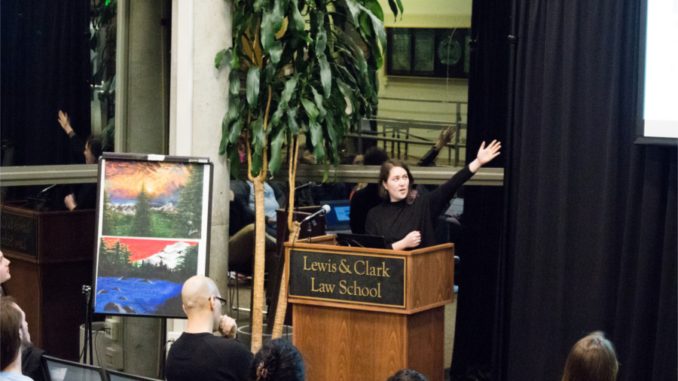
Students and community members came together to speak out against mass incarceration in the Lewis & Clark Law School’s annual Week Against Mass Incarceration (WAMI). Beginning on March 4, informative discussions and lectures took place featuring scholars, students and the voices of formerly incarcerated people. The National Lawyers Guild (NLG), a student-led organization committed to progressive change in political and economic systems, sponsors this event to spread awareness about the destructive impact of the prison-industrial complex.
On March 7, WAMI culminated in a powerful evening event, which showcased art created by formerly incarcerated people. Alongside the visual art exhibition, the NLG coordinated community organization tabling, poetry performances and a performance by an up-and-coming rapper.
This event was coordinated primarily by Maya Rinta, a 3L LC law student and NLG co-chair. She elaborated on the importance of the event and the mission of the NLG.
“I think the Week Against Mass Incarceration is an amazing event,” Rinta said. “The National Lawyers Guild National Membership in 2015 adopted a resolution supporting the abolition of the prison-industrial complex, which is a huge undertaking, but what that means is that we are striving for a world without prison, surveillance or police.”
Rinta is particularly focused on the issue of Oregon Ballot Measure 11. Passed in 1994, this law established mandatory minimum sentences for specific crimes ranging from robbery to manslaughter and enacted a youth waiver which automatically placed minors into the adult criminal justice system if they were convicted of a Measure 11 crime. This law subjected juveniles as young as 15 to receive adult criminal records. This law, in effect, has increased the number of prisoners with longer sentences, with a particularly profound effect on Oregon’s disadvantaged youth population.
“Part of Measure 11 was creating … a department of corrections for youth,” Rinta said. “There’s a quote in the task force report that says ‘hard beds for hardened youths,’ so it was very punitive.”
Rinta spearheaded the art exhibition, which is something the NLG does every year. Additionally, Rinta initiated the idea of including community organizations at the event. Ashley Needham, a 2L law student and member of the NLG, helped to coordinate a lunchtime lecture earlier that day. She said that Rinta had taken initiative with planning new aspects for this event.
“This year … (Rinta) really wanted to do something that had a lot of art and community organizations,” Needham said.
Representatives from a magazine called All Rise, a new publication which provides a platform for prisoners’ voices and art, spoke about their project. Attendees also could write postcards to the governor, who has the ability to commute sentences. Another organization, the Morpheus Youth Project, which runs art and expression programs for incarcerated youth, was also represented at the event.
Needham noted that these events are a crucial to influence policy decisions.
“Even in the most liberal cities, law school is incredibly conservative, really stifling and extremely problematic in every class you’re in,” Needham said. “The law is inherently racist, inherently homophobic, it really guides this whole system of oppression. So, I think this is one of the few ways that students are able to learn about some other stuff that is going on, learn from real people.”
Needham pointed out that only people who have experienced prison can truly understand and communicate the experience. Accordingly, an array of formerly incarcerated men were invited to speak and read poetry, which several did in emotional spoken word performance. Paul Henry Grice III, who spent time in Oregon State Penitentiary (OSP), was first to read his poetry. He rallied the crowd and encouraged people to support the movement by purchasing the anthology his work was recently published in, entitled “No Truth Barred: A collection of work by nine writers at the Oregon State Penitentiary.” Grice has worked with All Rise to find his artistic voice.
“It feels good to be able to say my whole name,” Grice said. “I used to be 15980751 … just a number. Now I’m a name. I’m a whole person.”
Grice spoke about the prevalence of racism in prisons, and how it divides prisoners to make them more easily controllable for the Department of Corrections (DOC) guards and administration.
“While you’re in prison, racism is intensified times 10 … I didn’t come into prison racist, and I damn straight coming out,” Grice said. “Understand that DOC, they want that to happen, because it’s what, 15 of them, controlling 800 of us. If all 800 got together being of one mind, you can’t stop us.”
Grice read a poem he wrote while incarcerated at OSP, entitled “Why Am I Not Black?”
The poem opens:
“When will I be black enough?
When I bang a hood? When the circumstances of poverty nurse a selfish decision to sell poison to my fellow man?
My skin is black,
but yet you scrutinize my struggle.
My scars are visible,
but yet you claim not to see them…”
Grice also emphasized the importance of resisting the prison industrial complex in any way possible.
“None of this would be possible without all of us,” Grice said. “You are actually a part of the solution. You may think, ‘oh I just came to an event, I’m just here, I just checked it out.’ You’re part of the solution and I thank you for your support. Without you, we wouldn’t be doing nothing. We’d be in the same position we was.”
Subscribe to the Mossy Log Newsletter
Stay up to date with the goings-on at Lewis & Clark! Get the top stories or your favorite section delivered to your inbox whenever we release a new issue.

Leave a Reply